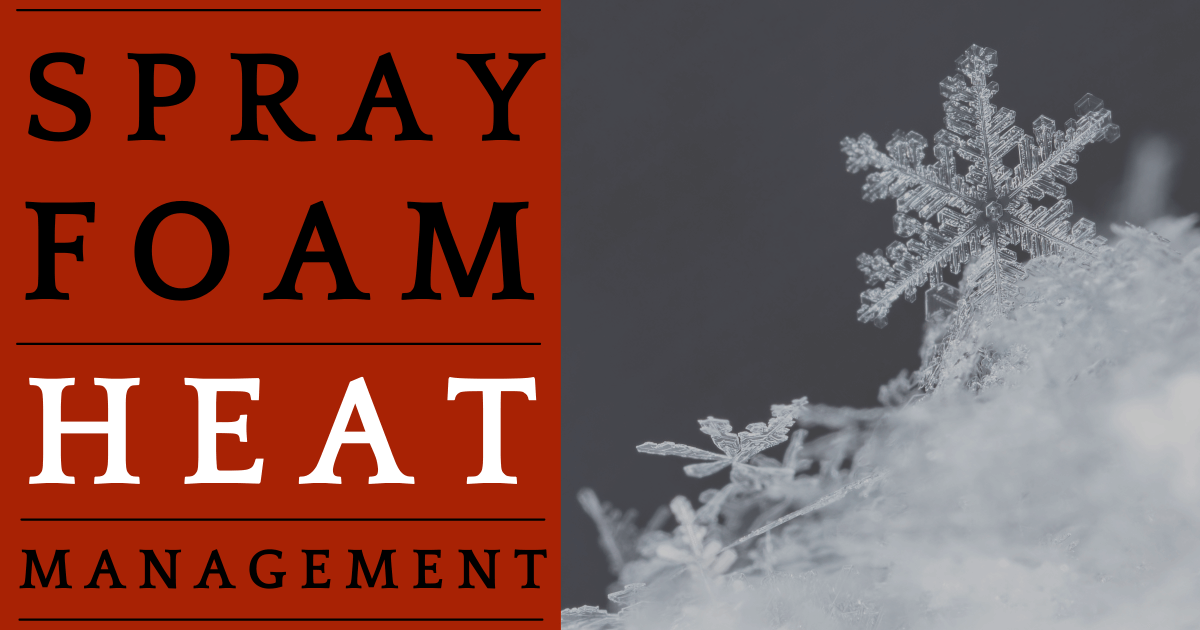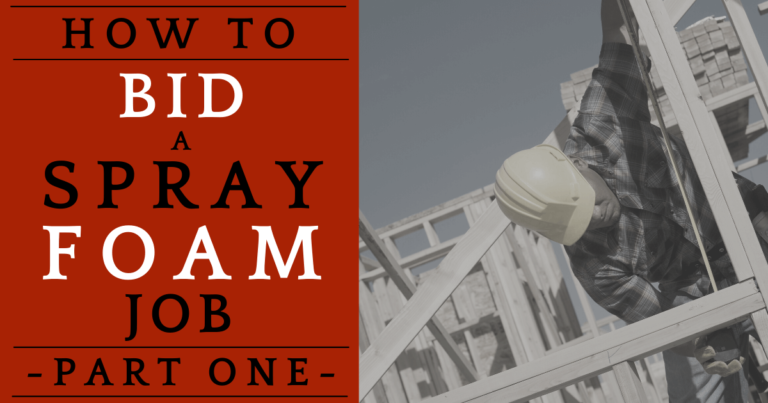Spray Foam Heat Management
We’ll give it to you straight: spraying foam insulation is challenging.
Anyone who says otherwise has never sprayed foam.
But every master of their field starts somewhere, right?
Whether you’re new to spray foam insulation or you’re starting from the ground up with a new brand of foam, all spray foam is finicky.
So start right where you are. (Yes, even with that malfunctioning mess of foam in front of you.)
Freedom Foam & Equipment, LLC is here to help!
We strive to build our blog so it can be a resource for you, and you can reach out to us whenever you need to!
We introduced spray foam insulation in our last blog post. Time to get down to the nitty-gritty!
The first in-depth spray foam topic to tackle: heat management.
The bottom line is this: spray foam wants to be nice and cozy, like your grandma’s cat. (Or your grandma.)
That’s right. Your spray foam dreams of curling up in the sun for a long nap.
Why do you think it keeps everyone in your house so warm in the winter? It’s all those cozy dreams, my friend.
Okay, all joking aside, creating the right conditions for your spray foam before, during, and after application will ensure optimal performance.
Optimally-performing spray foam saves you time and material.
Saving material means saving money.
“What!?” You say, “Letting your spray foam have its day in the sun saves you money??”
Yup!
Paying attention to your foam is really something, isn’t it?
Before Application: Material Storage & Equipment Mainenance
You’ve received the spray foam materials for that big, upcoming job…
And so it begins!
Truly, that spray foam job starts NOW…with material storage and equipment maintenance.
(Ooo! So exciting!)
Climate plays a huge role in the health of your future foam product.
Treating your spray foam materials with respect, like you would a treasured heirloom or your favorite coffee mug will save you time and money. Scout’s honor.
And it all starts with proper storage.
Let’s talk this through.
Spray foam relies on a chemical reaction to form, as you’re aware.
If your materials are damaged during storage, your final spray foam product will not look – or insulate – as it should.
How do you avoid that outcome? With heat management! (Yes, even before the spray foam job.)
Keeping your spray foam materials in a climate-controlled environment is essential to an optimally-functioning end-product.
Storing your materials barrels outdoors is not a good idea.
Extreme temperature variations can cause instability in the carefully-measured foam formulas, leading to misbehaving foam. All foam types and brands can be finicky, but closed-cell foams are especially temperature-sensitive.
Storage temperatures greater than ~80° F can also lead to bulging barrels, which can not only lead to unstable foam but are potentially dangerous.
If you must open a bulging barrel, MAKE SURE you are careful to open the bunghole with something other than your hand while facing away from the hole. DO NOT put your face over the hole, ya know!? Let any pressure released dissipate before inspecting your materials.
If you are unsure about the necessary storage temperatures for your foam barrels, take a look at the manufacturer’s technical data sheet or contact them directly.
In addition to material storage, equipment maintenance is essential to your spray foam’s seamless application and optimal performance.
Spray foam materials are (obviously) necessary to complete your foam job – but they are not the only part of the equation. You can’t spray foam insulation without functional equipment, so proper equipment maintenance is a non-negotiable!
The Takeaway: Store your spray foam insulation materials in a climate-controlled environment and properly maintain your spray foam equipment to ensure optimal performance while on the job.
During Application: Heat Management on the Job
You’ve hauled your precious (and cozy) spray foam materials to the job site in your spray foam rig. Now what?
Well, now you make sure that your foam is snoozing in its Snuggie, and get to spraying!
You started caring for your foam with climate-controlled storage.
Now, it is vital to keep your foam warm from the barrel to the substrate (or spray foam receiving surface).
Foam is pumped from the barrel to the transport lines, through your spray foam machine’s preheaters, out of the machine, and into your spray hose. Then, it travels down the length of the spray hose and enters your spray foam gun. In the mixing chamber of your spray foam gun, the two sides of your spray foam meet for the first time – and there is instant chemistry! The two shall never be torn asunder! Finally, the newly-mixed foam is sprayed on the substrate forever and ever, so be it.
Such is the “life cycle” of spray foam insulation.
The maturation process, if you will.
Every step in that process can pose heat management issues for you – so it is best to be prepared.
Your spray foam barrels – and the material within them – need to be warm…
The preheaters on your spray foam machine must produce adequate heat for your foam materials…
That heat must be maintained throughout the length of the spray hose…
And the substrate must be warm enough to receive the newly-mixed foam, creating the ideal environment for foam expansion.
If any piece of this timeline is disrupted, your foam could end up performing poorly or not reacting at all.
Cold in your spray foam rig cuz it’s -37° outside? Get on that!
Barrel heaters are available to keep your foam barrels nice and toasty for the whole day. They are great tools but are not always necessary. Everything depends on the conditions you’re spraying in; the preheat capabilities of your spray foam machine, etc.
There are also hose insulators to help keep your spray foam hose off the ground and maintain the heat of your spray foam along the line.
With proper heat management, you may not need those either – especially if your hose heat is performing well!
There’s no replacement for great preheaters and hose heat.
How do you ensure a warm substrate? That can be difficult sometimes.
Here’s a free trick that we use: spray with the sun!
It may sound like an age-old remedy for the flu, but starting with the easternmost section of your spray foam job in the morning and following the path of our life-giving star throughout the day truly helps jump-start substrate heat.
Space heaters can also help warm the spray foam receiving surface – and help keep you warm, too!
If the substrate is too cold, your foam will not adhere to the substrate properly and may have difficulty expanding.
How do you find the “Goldilocks Zone” of foam? Well, follow the foam manufacturer’s guidelines first…and then, using trial and error, employ the greatest of all scientific tools: observation.
Pay attention to the temperature of your spray foam and the substrate, and take note of the reactions that occur when you change one thing at a time.
Science is amazing!
After a while, you’ll get a feel for the needs of your particular spray foam formulation, and you’re off to the races.
After Application: If Spray Foam Could Talk
Have you noticed an issue with your spray foam?
STOP SPRAYING!!
Good.
Now, let’s figure out the issue and avoid a huge mess!
Yes, it’s tempting to just keep going – daylight is a-burning and all – but whatever issue you’ve noticed won’t just fix itself. You aren’t going to spray away the problem.
In fact, trying to spray through the issue will likely make things worse, not better.
If you’ve performed the necessary equipment maintenance – your spray foam gun is clean, etc. – then heat management may be the problem. Here are some things to look for:
Spray Foam is Too Hot
If you notice that your spray foam is expanding too quickly, peeling off the wall, or shrinking, your spray foam may be too hot.
Another warning sign is a striping or “fingering” spray pattern from the spray foam gun. Normally round and full, a striped, broken spray pattern indicates your materials are too hot.
Upon noticing this issue, stop spraying and adjust the preheat and hose heat to a lower temperature. Then, take a break for a minute to let things cool down and resume spraying!
Simple fixes are the best, aren’t they??
Spray Foam is Too Cold
If your spray foam is too cold, it will expand too slowly or not enough. Check the heat of both the foam and substrate, and kick up the cozy where necessary! Your foam will thank you.
Keep these temperature warning signs in mind – adjusting as necessary – and you are bound to notice more efficient spray foam coverage on the job. The more efficient the coverage, the more spray foam material you’ll have leftover after completing this job – and that means you can use it on the next one! Money in your pocket.
You’re welcome!
Conclusion
Temperature conditions play a huge role in the health of your spray foam insulation.
Too hot, and the porridge burns Goldilocks’s mouth…just kidding! (Don’t eat spray foam!) But you want to find a happy temperature medium and spray your foam using the ideal conditions. There are countless helpful gadgets for assisting you with this job – but nothing can be substituted for paying attention.
Given enough time, you’ll learn to identify the issues that your foam communicates through its behavior.
In practice, foam’s temperature needs are relatively consistent across the board. You will need to watch the gauges and the end product regardless of how “amazing” the material you spray is or how “specifically-formulated” it is.
Spray foam is not foolproof.
You are the key ingredient that turns a run-of-the-mill spray foam job into a well-insulated home or office.
Without a watchful eye, your job as a spray foam contractor will be incredibly difficult.
So.
When it comes to heat management, pay attention to…
The outdoor conditions (in storage and on the job)…
Your temperature gauges…
The substrate temps…
And above all…
Pay attention to the way your foam behaves.
With a keen eye, you can quickly diagnose the heating issues that arise on the spray foam job and get right back to spraying!
If you’re in doubt, refer to the technical data sheet for your foam.
Still stumped?
Give Freedom Foam & Equipment a holler!
We have years of experience spraying foam and will gladly help you navigate your spray foam difficulties.
That’s what we are here for!







